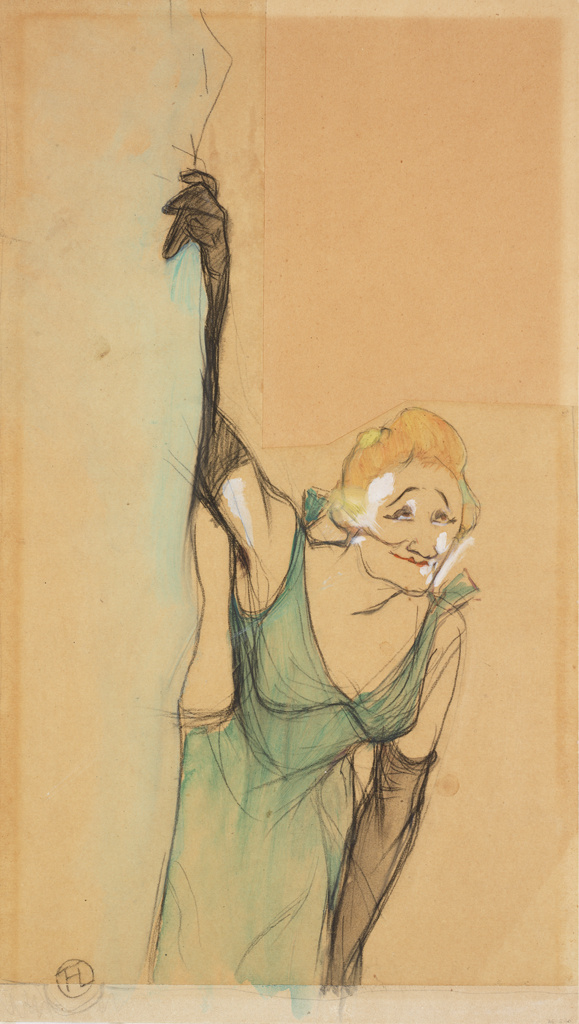log in
Enter site
Login to use Arthive functionality to the maximum
Yvette Guilbert salue le public
Henri de Toulouse-Lautrec • Peinture, 1894, 41.7×24.5 cm
Descriptif de la toile «Yvette Guilbert salue le public»
Toulouse-Lautrec was bewitched by the cabarets and cafes of the Parisian quarter of Montmartre. He befriended many artists and contributed to their growing popularity by creating posters and advertisements for them. Perhaps the most famous of these performers was Yvette Gilbert. In this watercolor sketch for the Yvette Gilbert Album series of lithographs, the artist depicted the singer in her "signature" outfit - a simple green dress with a deep V-neck front and back and black long gloves. Yvette herself wrote about them: "The black gloves were a symbol of sophistication, which I could bring to this hooligan and slightly simple atmosphere.".
Yvette Gilbert (real name Emma Laura Esther Gilbert) was a true Fin-de-siècle icon of Paris, performing in such establishments as the Japanese Couch and the Moulin Rouge. She met Toulouse-Lautrec in early 1893 through the writer Maurice Donné and became one of his favorite models. In this portrait, the artist "catches" her in the foreground: the singer casually holds the closing curtain with a gesture and prepares to curtsy to the applauding audience.
Guilbert graduated in recitation, but began singing in café chanteaus and cabarets, not content with third-rate roles in the theater. In this case, she did not have the traditional beauty - was tall, thin and snub nose - and a good voice, but she skillfully used their shortcomings to stand out among his more talented fellow artists. According to the recollections of contemporaries, Yvette did not sing, but rather spoke her songs. But her unique way of singing "pervaded the fog of smoke, alcoholic fumes, and breath." - The critic Gustave Geoffroy wrote in Toulouse-Lautrec's Album.
Yvette Gilbert owed much of her success to Léon Xanrof and Aristide Bruant, who wrote songs for her, but she also sometimes sang her own compositions. Some of these were about the tragic love of the Parisian classes, while others struck with bold lyrics full of obscene innuendo. During a tour of Italy, the United States and England beginning in 1895, she shocked audiences with the contrast between her haggard, decadent appearance and her bold songs.
Toulouse-Lautrec did not seek to conceal Guilbert's defects. On the contrary, he exaggerated her awkward figure and upturned nose to emphasize the individuality of his model. Although the singer herself did not appreciate his manner (she is about 26 years old in this portrait, for example!), nevertheless, the album of lithographs greatly increased her recognition and fame.
Yvette Gilbert (real name Emma Laura Esther Gilbert) was a true Fin-de-siècle icon of Paris, performing in such establishments as the Japanese Couch and the Moulin Rouge. She met Toulouse-Lautrec in early 1893 through the writer Maurice Donné and became one of his favorite models. In this portrait, the artist "catches" her in the foreground: the singer casually holds the closing curtain with a gesture and prepares to curtsy to the applauding audience.
Guilbert graduated in recitation, but began singing in café chanteaus and cabarets, not content with third-rate roles in the theater. In this case, she did not have the traditional beauty - was tall, thin and snub nose - and a good voice, but she skillfully used their shortcomings to stand out among his more talented fellow artists. According to the recollections of contemporaries, Yvette did not sing, but rather spoke her songs. But her unique way of singing "pervaded the fog of smoke, alcoholic fumes, and breath." - The critic Gustave Geoffroy wrote in Toulouse-Lautrec's Album.
Yvette Gilbert owed much of her success to Léon Xanrof and Aristide Bruant, who wrote songs for her, but she also sometimes sang her own compositions. Some of these were about the tragic love of the Parisian classes, while others struck with bold lyrics full of obscene innuendo. During a tour of Italy, the United States and England beginning in 1895, she shocked audiences with the contrast between her haggard, decadent appearance and her bold songs.
Toulouse-Lautrec did not seek to conceal Guilbert's defects. On the contrary, he exaggerated her awkward figure and upturned nose to emphasize the individuality of his model. Although the singer herself did not appreciate his manner (she is about 26 years old in this portrait, for example!), nevertheless, the album of lithographs greatly increased her recognition and fame.


